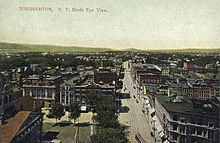McDowell Memo: The Valley of Opportunity and what it taught
The Valley of Opportunity
Valley of Opportunity: Growth as a manufacturing hub[edit]
Binghamton incorporated as a city in 1867 and, due to the presence of several stately homes, was nicknamed the Parlor City.[9] In the late 19th and early 20th centuries, many immigrants moved to the area, finding an abundance of jobs. During the 1880s, Binghamton grew to become the second-largest manufacturer of cigars in the United States.[10] However, by the early 1920s, the major employer of the region became Endicott Johnson, a shoe manufacturer whose development of welfare capitalism resulted in many amenities for local residents.[19] An even larger influx of Europeans immigrated to Binghamton, and the working class prosperity resulted in the area being called the Valley of Opportunity.[10][19]
In 1913, 31 people perished in the Binghamton Clothing Company fire, which resulted in numerous reforms to the New York fire code.[20][21] Major floods in 1935 and 1936 resulted in a number of deaths, and washed out the Ferry Street Bridge (now the Clinton Street Bridge). The floods were devastating, and resulted in the construction of flood walls along the length of the Susquehanna and Chenango Rivers.[10][22]
During the Second World War, growth and corporate generosity continued as IBM, which was founded in greater Binghamton, emerged as a global technology leader.[23] Along with Edwin Link's invention of the flight simulator in Binghamton, IBM transitioned the region to a high-tech economy. Other major manufacturers included Ansco and General Electric.[9] Until the Cold War ended, the area never experienced an economic downfall, due in part to its defense-oriented industries.[10] The population of the city of Binghamton peaked at around 85,000 in the mid-1950s.[24]
I grew up in this climate of endless economic potential but more importantly those of us born in the 50's and 60's would see major upheaval but coming from the Triple Cities we saw what big business could do to take care of the employee. It started with Endicott Johnson and George F. Johnson.
and continued with IBM and the Watsons
These men practiced what many called "Welfare Capitalism" where they met the needs of employees and therefore got tremendous loyalty and effort. Johnson built hospitals, carousels, parks , He ran stores to get the food and other items at the best price, He built his employees homes and allowed them to pay for them through their paycheck weekly. Watson took it a step up with insisting on the highest wages for his employees and demanding they all come to work in a white shirt and dark tie . Thousands of persons streamed across the country to work for these men. All of us growing up here wanted nothing but a good job at IBM . But the world turned its back on Welfare Capitalism and thus killed the greatest social experiment of the century. And it forced so many of us to move away, but always looking for another Valley of Opportunity.


Comments
Post a Comment